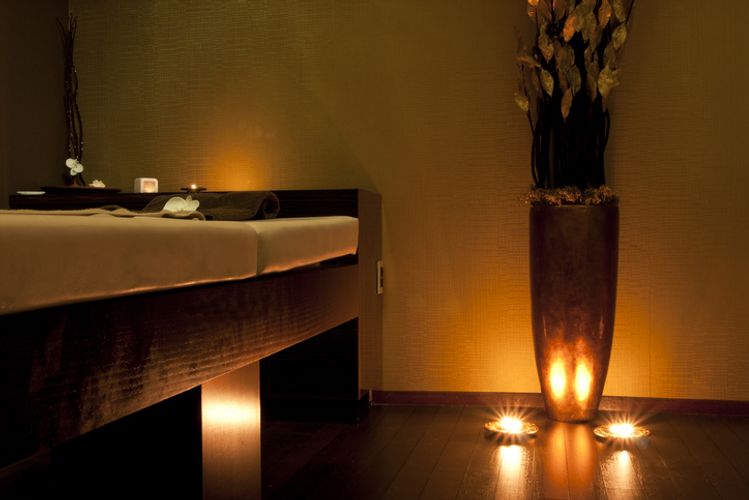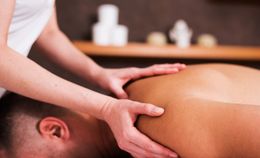If you are interested in therapeutic massage, chances are you are seeking relief from specific symptoms or help managing a particular health condition.
Broadly speaking, all massage practice is in some ways therapeutic, in the sense of providing benefits supporting clients, health and well-being.1 All forms of massage reduce muscle tension by applying manual strokes, kneading and/or pressure to the body's soft tissues, resulting in relief of aches and pains, greater mobility, and physical and psychological relaxation.
In the past, many people saw massage and its effects as primarily as a luxury service or personal indulgence. However, massage therapy is now widely and increasingly recognized by medical researchers, health care providers, and the general public for its powerful positive health and wellness impacts 2and its usefulness in treating the symptoms of a range of conditions.3
The phrase "therapeutic massage" captures this updated understanding of massage therapy practice.
What differentiates a therapeutic massage?
"Therapeutic massage" refers to any massage given with the goal of providing treatment for a client's symptoms or health concerns. The term is meant to distinguish a massage as serving a purpose or goal related to client health and wellness, in contrast to massage for relaxation or pleasure alone.4
There is no one type of therapeutic massage; rather, the phrase indicates that the massage therapist has designed the session around specific client needs and goals, employing whatever massage modalities and techniques might be useful in meeting them. Sometimes this is in tandem with standard medical treatment in a medical office or hospital setting;5 in this context you might also hear the phrase "medical massage" used interchangeably with "therapeutic massage".
Some types of massage are more often employed with therapeutic goals in mind. The following types of massage are often used to treat specific symptoms and conditions:
- Deep tissue massage6: This type of massage aims to impact the deep layers of muscle and connective tissue to provide effective relief from tightness and stiffness that may be limiting range of motion and causing pain, either directly by acting on other areas of the body, or by causing postural and movement dysfunctions that in turn give rise to pain and discomfort. This type of massage is also very useful in addressing tightness and soreness caused by athletic activity and in supporting peak athletic performance by enhancing mobility, flexibility, and function.
- Myofascial release also addresses trigger points.Myofascial release: This technique focuses on the tough, strong connective tissues that wrap around and support your muscles, called myofascial tissues. The massage therapist will identify areas of myofascial tissue that feel tough, stiff, and less elastic when pressed, then work to loosen these areas to allow greater movement and provide pain relief, both locally and sometimes elsewhere in the body (this is called referred pain).7
- Trigger point therapy: Trigger points are small muscle spasms or knots, caused by overuse, that are thought to cause referred pain. Trigger point therapy involves identifying these knots and applying finger pressure directly to them for a sustained period - sometimes as long as 90 seconds - until the client reports a release of tension and (usually) an alleviation of pain. Many clients find this technique very effective in achieving pain relief from a variety of conditions, including sciatica, spinal stenosis, frozen shoulder, plantar fasciitis, and more.8 Myofascial release also addresses trigger points.
The above listed massage modalities are usually aimed more toward therapeutic outcomes than relaxation, primarily because the experience of these techniques during a massage session can feel intense and even uncomfortable - even though they may provide quite effective pain relief afterward.
If you are interested in myofascial release, trigger point therapy or deep tissue massage, it is important to find a licensed massage therapist with specific training and experience in these techniques. Tell them what ailments you hope to treat in a session and ask them about their experience aiding similar clients and what approach they propose.
Any high-quality professional massage therapist who practices these therapeutic techniques should stress the importance of communication before and during a session, and invite you to provide frequent feedback to assist in your own best care.
Other massage modalities besides these may also be used in the context of therapeutic or medical massage depending on your needs. Many health conditions respond best to massage therapy in the context of a regular therapeutic massage program.
A therapeutic massage session is also likely to incorporate discussion of the history of your symptoms and what factors seem to impact them as well as recommendations for home care. These may include exercises, stretching and postural adjustments.
Is therapeutic massage right for you?
There is increasing evidence for massage therapy as a safe, effective treatment option for a range of symptoms and conditions, including:
- Arthritis: Massage has been shown to reduce pain and improve range of motion in patients with osteoarthritis9 and rheumatoid arthritis.10
- Cardiovascular health: Research shows massage therapy can reduce blood pressure and reduce stress and anxiety in cardiac surgery patients.11
- Fibromyalgia: Studies have shown massage therapy can help decrease pain, alleviate anxiety and depression, and improve sleep in fibromyalgia patients12
- Migraine headaches: Studies offer evidence that regular massage therapy may reduce the incidence and severity of migraine headaches.13
- Tension headaches: Massage therapy has been shown to help sufferers of chronic tension headaches by improving autonomous nervous system regulation and reducing psychological symptoms linked to this condition.14
- Low-back pain: Research shows that regular massage therapy can be effective in helping to manage chronic low-back pain by reducing the severity of pain as well as levels of disability, depression, and anxiety associated with it.15
- Mental health problems including depression, anxiety, PTSD, and insomnia: Massage therapy has been shown to improve psychological well-being, reduce symptoms and improve sleep,161718 including in surgery and oncology patients, postpartum women, and premature infants.
- Sports performance: Massage therapy is used by many professional athletes to help reduce pain from repetitive stress and muscle strain, support injury recovery, and maintain range of motion and flexibility to improve performance and prevent injury.19
- Pain from a variety of causes: Studies show massage therapy is beneficial in pain management20 and many health care practitioners, patients, and public health professionals are increasingly calling for greater use of massage therapy as a far safer, first-line treatment alternative to opioid drug treatment whenever possible.21
The Bottom Line
Aside from helping to treat specific conditions, keep in mind that massage's best-known benefits are in the areas of pain relief, stress reduction, and relaxation.
Massage is a minimally risky method for achieving these common goals, meaning massage therapy may aid some people in avoiding side effects from more invasive or risky methods of achieving relief from stress and pain (alcohol consumption, medication, surgery, etc.).
Finally, reducing stress and incorporating regular self-care into your everyday routine is a wise move to help you reduce the risk of developing a range of health problems over time. Many people find massage therapy to be a powerful tool to support their overall long-term health and wellness.
References:
1 "What is the Difference Between a Therapeutic Massage and a Regular Relaxation Massage?": https://manylivescm.com/what-is-the-difference-between-a-therapeutic-massage-and-a-regular-relaxation-massage/
2 "Massage for Health Conditions": https://www.amtamassage.org/infocenter/healthcare_articles-and-associations.html
3 "Therapeutic Massage for Pain Relief": https://www.health.harvard.edu/alternative-and-complementary-medicine/therapeutic-massage-for-pain-relief
4 "What is Therapeutic Massage Therapy?": https://bouldertherapeutics.com/what-is-therapeutic-massage-therapy/
5 "Why You Should Try Medical or Therapeutic Massage": https://health.clevelandclinic.org/therapeutic-massage-can-great-addition-treatment/
6 "Therapeutic Deep Tissue Massage": https://bouldertherapeutics.com/services/massage-styles/therapeutic-deep-tissue/
7 "Myofascial Trigger Point Therapy - What Is It?": https://namtpt.wildapricot.org/MTPT_What_is_it
8 "Massage and Trigger Points": https://www.amtamassage.org/publications/massage-therapy-journal/massage-and-trigger-points/
9 "Massage Therapy for the Pain of Osteoarthritis of the Knee": https://www.amtamassage.org/publications/massage-therapy-journal/client-handout-osteoarthritis/
10 "Massage and Rheumatoid Arthritis": https://www.amtamassage.org/articles/3/MTJ/detail/2807/massage-rheumatoid-arthritis
11 "Cardiovascular Heald and Massage Therapy": https://my.amtamassage.org/courses/detail/79/cardiovascular-health-and-massage-therapy
12 "Massage + Fibromyalgia: The Right Touch": https://www.amtamassage.org/publications/massage-therapy-journal/massage-and-fibromyalgia/
13 "Tackling Migraines Head-On": https://www.amtamassage.org/articles/3/MTJ/detail/3704/tackling-migraines-head-on
14 "The Power of Touch for Tension Headaches": https://www.amtamassage.org/about/position-statements/massage-effective-for-tension-headaches/
15 "Massage Therapy Can Be Effective for Low Back Pain": https://www.amtamassage.org/about/position-statements/massage-therapy-can-be-effective-for-low-back-pain/
16 "Massage Therapy Can Help Improve Sleep": https://www.amtamassage.org/about/position-statements/massage-therapy-can-help-improve-sleep/
17 "In Safe Hands: Massage Therapy & PTSD": https://www.amtamassage.org/articles/3/MTJ/detail/3484/in-safe-hands-massage-ptsd
18 "Massage + Depression": https://www.amtamassage.org/articles/3/MTJ/detail/2942/massage-depression
19 "Massage Therapy for Those Who Exercise": https://www.amtamassage.org/about/position-statements/massage-therapy-for-those-who-exercise/
20 "Advocacy Work on Massage for Pain Management": https://www.amtamassage.org/advocacy/federal-priorities/advocacy-massage-for-pain-management/
21 "Massage Therapy as an Alternative to Opioids": https://www.amtamassage.org/resources/massage-and-health/alternative-to-opioids/





















